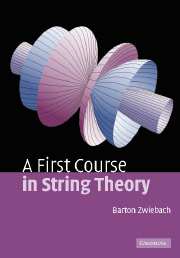Book contents
- Frontmatter
- Contents
- Foreword
- Preface
- Acknowledgements
- Part I Basics
- Part II Developments
- 14 D-branes and gauge fields
- 15 String charge, electric charge, and particle physics
- 16 String thermodynamics and black holes
- 17 T-duality of closed strings
- 18 T-duality of open strings
- 19 Electromagnetic fields on D-branes
- 20 Nonlinear and Born–Infeld electrodynamics
- 21 Covariant string quantization
- 22 String interactions and Riemann surfaces
- 23 Loop amplitudes in string theory
- References
- Index
23 - Loop amplitudes in string theory
from Part II - Developments
- Frontmatter
- Contents
- Foreword
- Preface
- Acknowledgements
- Part I Basics
- Part II Developments
- 14 D-branes and gauge fields
- 15 String charge, electric charge, and particle physics
- 16 String thermodynamics and black holes
- 17 T-duality of closed strings
- 18 T-duality of open strings
- 19 Electromagnetic fields on D-branes
- 20 Nonlinear and Born–Infeld electrodynamics
- 21 Covariant string quantization
- 22 String interactions and Riemann surfaces
- 23 Loop amplitudes in string theory
- References
- Index
Summary
To calculate scattering amplitudes with high accuracy, one must include the contribution from diagrams which contain loops that represent virtual processes. In Einstein's theory of gravity these diagrams give rise to ultraviolet divergences, which reveal intractable short-distance phenomena. String theory contains gravity, but there are no such ultraviolet divergences. The Riemann surfaces that are candidates for short-distance problems admit an interpretation where they clearly describe safe, long-distance phenomena. We illustrate this remarkable property for the case of annuli, which are the surfaces relevant to virtual open string processes, and for the case of tori, which are the surfaces relevant to virtual closed string processes.
Loop diagrams and ultraviolet divergences
When calculating scattering amplitudes in particle physics, one typically uses an approximation scheme in which the strength of the interactions is assumed to be small. The amplitude is then written in terms of a perturbative series expansion in powers of this small interaction parameter. The Feynman diagrams we considered in Chapter 22 and the similar looking string diagrams were all tree diagrams. This means that the graphs (see, for example, Figure 22.2) contain no nontrivial closed paths, or loops. Tree diagrams give the first term in the perturbative expansion of scattering amplitudes. To go beyond this lowest-order approximation, one must consider Feynman diagrams with loops.
Consider the Feynman diagram with a loop shown in Figure 23.1. This diagram represents an incoming particle which splits into two particles that rejoin to form an outgoing particle.
- Type
- Chapter
- Information
- A First Course in String Theory , pp. 518 - 546Publisher: Cambridge University PressPrint publication year: 2004



